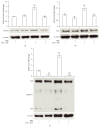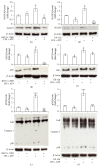A Novel Role for Brain Natriuretic Peptide: Inhibition of IL-1β Secretion via Downregulation of NF-kB/Erk 1/2 and NALP3/ASC/Caspase-1 Activation in Human THP-1 Monocyte
- PMID: 28331244
- PMCID: PMC5346358
- DOI: 10.1155/2017/5858315
A Novel Role for Brain Natriuretic Peptide: Inhibition of IL-1β Secretion via Downregulation of NF-kB/Erk 1/2 and NALP3/ASC/Caspase-1 Activation in Human THP-1 Monocyte
Abstract
Interleukin-1β (IL-1β) is a pleiotropic cytokine and a crucial mediator of inflammatory and immune responses. IL-1β processing and release are tightly controlled by complex pathways such as NF-kB/ERK1/2, to produce pro-IL-1β, and NALP3/ASC/Caspase-1 inflammasome, to produce the active secreted protein. Dysregulation of both IL-1β and its related pathways is involved in inflammatory/autoimmune disorders and in a wide range of other diseases. Identifying molecules modulating their expression is a crucial need to develop new therapeutic agents. IL-1β is a strong regulator of Brain Natriuretic Peptide (BNP), a hormone involved in cardiovascular homeostasis by guanylyl cyclase Natriuretic Peptide Receptor (NPR-1). An emerging role of BNP in inflammation and immunity, although proposed, remains largely unexplored. Here, we newly demonstrated that, in human THP-1 monocytes, LPS/ATP-induced IL-1β secretion is strongly inhibited by BNP/NPR-1/cGMP axis at all the molecular mechanisms that tightly control its production and release, NF-kB, ERK 1/2, and all the elements of NALP3/ASC/Caspase-1 inflammasome cascade, and that NALP3 inflammasome inhibition is directly related to BNP deregulatory effect on NF-kB/ERK 1/2 activation. Our findings reveal a novel potent anti-inflammatory and immunomodulatory role for BNP and open new alleys of investigation for a possible employment of this endogenous agent in the treatment of inflammatory/immune-related and IL-1β/NF-kB/ERK1/2/NALP3/ASC/Caspase-1-associated diseases.
Conflict of interest statement
The authors declare that there is no conflict of interests regarding the publication of this study.
Figures







Similar articles
-
Atrial natriuretic peptide down-regulates LPS/ATP-mediated IL-1β release by inhibiting NF-kB, NLRP3 inflammasome and caspase-1 activation in THP-1 cells.Immunol Res. 2016 Feb;64(1):303-12. doi: 10.1007/s12026-015-8751-0. Immunol Res. 2016. PMID: 26616294
-
Aloe vera downregulates LPS-induced inflammatory cytokine production and expression of NLRP3 inflammasome in human macrophages.Mol Immunol. 2013 Dec;56(4):471-9. doi: 10.1016/j.molimm.2013.05.005. Epub 2013 Aug 1. Mol Immunol. 2013. PMID: 23911403
-
Fluorofenidone attenuates pulmonary inflammation and fibrosis via inhibiting the activation of NALP3 inflammasome and IL-1β/IL-1R1/MyD88/NF-κB pathway.J Cell Mol Med. 2016 Nov;20(11):2064-2077. doi: 10.1111/jcmm.12898. Epub 2016 Jun 16. J Cell Mol Med. 2016. PMID: 27306439 Free PMC article.
-
The inflammasome, autoinflammatory diseases, and gout.Joint Bone Spine. 2007 Dec;74(6):571-6. doi: 10.1016/j.jbspin.2007.04.004. Epub 2007 Aug 21. Joint Bone Spine. 2007. PMID: 17714972 Review.
-
The inflammasome: an emerging therapeutic oncotarget for cancer prevention.Oncotarget. 2016 Aug 2;7(31):50766-50780. doi: 10.18632/oncotarget.9391. Oncotarget. 2016. PMID: 27206676 Free PMC article. Review.
Cited by
-
Monocyte Subsets in Patients with Chronic Heart Failure Treated with Cardiac Resynchronization Therapy.Cells. 2021 Dec 9;10(12):3482. doi: 10.3390/cells10123482. Cells. 2021. PMID: 34943990 Free PMC article.
-
NLRP3 inflammasome: a new therapeutic target for high-risk reproductive disorders?Chin Med J (Engl). 2020 Nov 4;134(1):20-27. doi: 10.1097/CM9.0000000000001214. Chin Med J (Engl). 2020. PMID: 33395071 Free PMC article.
-
Mitochondrial STAT3 exacerbates LPS-induced sepsis by driving CPT1a-mediated fatty acid oxidation.Theranostics. 2022 Jan 1;12(2):976-998. doi: 10.7150/thno.63751. eCollection 2022. Theranostics. 2022. PMID: 34976224 Free PMC article.
-
ANP and BNP Exert Anti-Inflammatory Action via NPR-1/cGMP Axis by Interfering with Canonical, Non-Canonical, and Alternative Routes of Inflammasome Activation in Human THP1 Cells.Int J Mol Sci. 2020 Dec 22;22(1):24. doi: 10.3390/ijms22010024. Int J Mol Sci. 2020. PMID: 33375031 Free PMC article.
-
Inflammation and Circulating Natriuretic Peptide Levels.Circ Heart Fail. 2020 Jul;13(7):e006570. doi: 10.1161/CIRCHEARTFAILURE.119.006570. Epub 2020 Jun 8. Circ Heart Fail. 2020. PMID: 32507024 Free PMC article.
References
MeSH terms
Substances
LinkOut - more resources
Full Text Sources
Other Literature Sources
Miscellaneous

